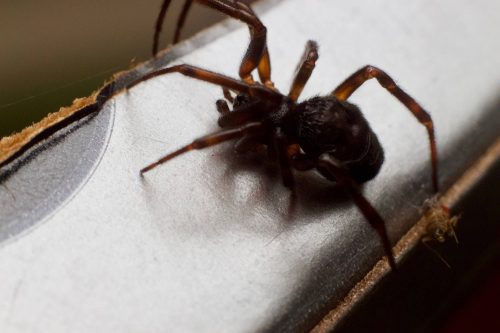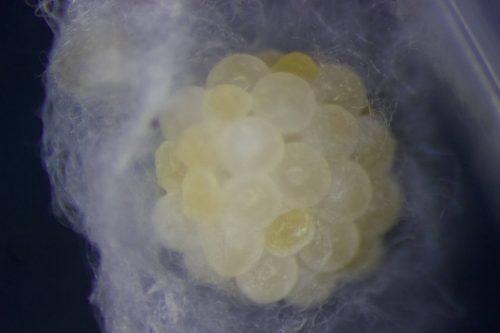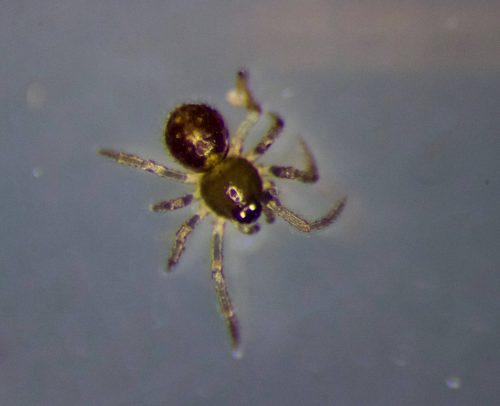This is Monica.
Monica is Steatoda borealis, and she’s huge. She’s twice the size of our Parasteatoda, and looks simply immense after working with our familiar little guys. She’s big even for S. borealis.
I gave her away to another home earlier this summer. A student was looking for a pet spider, and had a nice terrarium setup, and was going to feed her crickets, so it was safe. She showed up at my door today with Monica, and asked, “Is that an egg sac?”
Sure is. Then she said, “I’m not ready to take care of a family,” a very responsible attitude to have, “would you take her back?” And of course I would. So I brought her back to the lab, and set her up in a nice spacious cage, and fed her lots of flies. I pulled out the egg sac and put it in a Petri dish, and that’s when I notice all the little black dots scurrying around in her old jar. This wasn’t Monica’s first go-round. She’d laid an earlier egg sac, unnoticed, which had hatched out probably last week, and laid a second sac, which we’d finally noticed. Here’s one of the many S. borealis babies.
So now I’ve got hundreds of P. tepidariorum babies, a half dozen S. triangulosa babies, and on top of that I’ve just added what looks like 40 or so S. borealis juveniles, and a clutch of S. borealis eggs to nurse. All of these have appeared at my lab door in the last two weeks. Hey, it’s nice, but did they all have to appear at once?





It would seem your student still has a virile male Steatoda borealis on her premises….
No, they store sperm, so she probably mated before I caught her.
Weird synchronicity: Yesterday, The Clinton Affair, part I, was on the telly. Today I binge-watched the rest of the six-part documentary. Now that was Monica’s story.
Kavanaugh already had his cry-baby face, then.
I am reminded of the drug store scene in The Mist.
Other weird organisms: We (vertebrates) are apparently more closely related to sea squirts than to the amphixous.
And sea squirts actually look as weird as spiders (but less threathening).
You should get a Portia spider, they are surprisingly clever predators, for arachnids.
hearing about your spider adventures I am becoming curious not living in a place with the extremes of weather and seasons.
How do the seasons effect the reproduction of the spiders, do some species peak in numbers early and some late. How does that relate to their prey animals reproduction cycles in the seasons.
uncle frogy
Right, but they hunt other spiders.
#7: That’s why we’re doing a survey! We already knew informally that numbers of all spiders dropped sharply in the winter, but we’re trying to pin some quantitative numbers on that.
If you want to see some excellent photographs and videos of spiders, I can highly recommend Dani’s Backyard Macro Safari. Her enthusiasm is catching, and her photography is second to none. https://www.facebook.com/TheSpiderWhisperer/